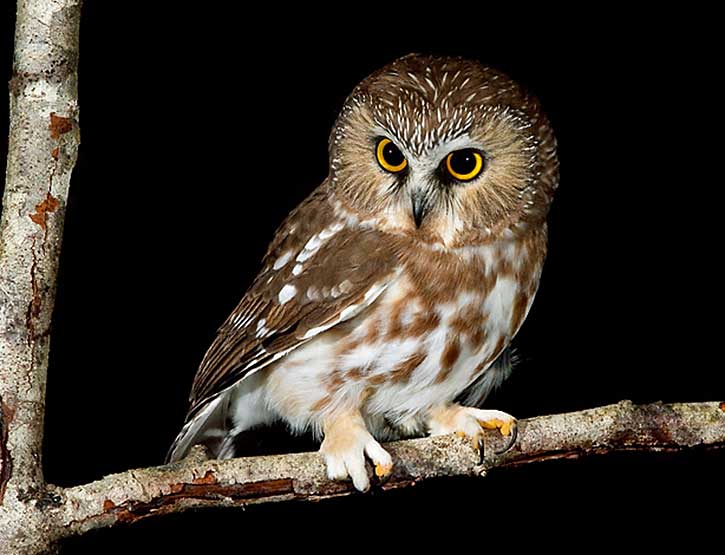The Northern Saw-whet Owl (Aegolius acadicus) is a small, cute owl with a round head, yellow eyes, and thick brown streaks on its underparts.
This nocturnal species lives in coniferous and mixed forests in Canada, the northern and western USA.
If you hear a repeated, tooting whistled call at night in northern or western coniferous or mixed forests, you are probably hearing a Northern Saw-whet Owl. These small owls are tough to see but can be found roosting in evergreen trees during migration and winter.
On this page
Identification
Male
The male Northern Saw-whet Owl is a small, plump bird around the same size as a Red-winged Blackbird. It is just 7.5 inches long, has a 16 inch wingspan, and only weighs 2.8 ounces. It is dark brown above, has thick, red-brown streaks on white underparts, and some white above and below its eyes.
Northern Saw-whet Owls also have a grayish-brown face, and fine white streaks on their gray-brown heads. They have prominent yellow eyes, a small black beak, and tawny feathered legs with long, sharp black talons.
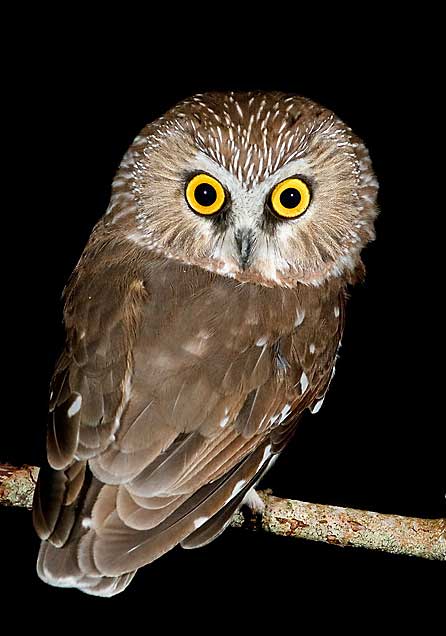
Females look almost identical to males, but are slightly bigger in size.
Male Northern Saw-whet Owls can sing their whistled-tooting song for several minutes.
Female
The female Northern Saw-whet Owl looks like the male but is noticeably larger. She is 8.2 inches long, has a 17 inch wingspan, and weighs 4.2 ounces.
These small owls also have white spotting where their wings meet their body, and small white spots on other parts of their broad, rounded wings.
Young birds of both sexes are dark brown with tawny underparts, and have a prominent white mark in the middle of their face.
Like male birds, female Northern Saw-whet Owls also sing a whistled tooting song in spring, but it is quieter and given less often.
Food
Northern Saw-whet Owls feed on small rodents, some small birds, insects, and some other small creatures. In most parts of their breeding range, their diet largely consists of mice, shrews, voles, and other small rodents.
However, Northern Saw-whet Owls that live on the Haida Gwaii islands off the coast of British Columbia also feed on isopods, spiders, and other marine invertebrates.
This species also catches moths, beetles, and other insects from time to time and occasionally feeds on bats. In winter and migration, they still eat small rodents but also catch small birds. They can prey on chickadees, juncos, kinglets, and even birds up to the size of a thrush.
When the opportunity presents itself, this owl species also occasionally catches juvenile birds.
Although wintering birds sometimes catch prey during the day, most of the time, they hunt during the dark of the night. They forage by waiting on a low perch at the edge of woods or in another semi-open spot. When the owl detects a mouse or other small animals, it glides down to catch it with its sharp talons.
If they catch a bird, they usually pluck it on the ground. These owls bring other animals back to their perch and eat it bit by bit.
Nesting and Eggs
Northern Saw-whet Owls form pairs from January to April and the female probably chooses the nest site. She picks an old woodpecker nest, usually a hole made by a Northern Flicker or a Pileated Woodpecker. She can also use an artificial nest box.
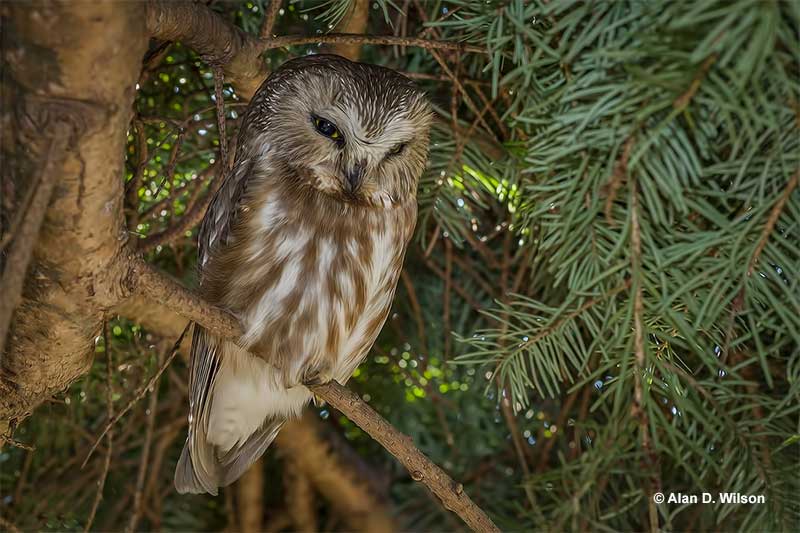
Their nesting holes can be anywhere from eight to more than forty feet above the ground and they don’t add any nesting material to the cavity, Instead, the female lays three to seven eggs directly on the wood chips, old starling nest, or other debris at the bottom of the hole.
The eggs are white and are 1.18 inches long. The mother owl incubates her eggs for 26 to 28 days. During that time and for 18 days after the last eggs hatches, the male brings food to his mate and the nestlings. By then, the mother owl also starts to feed her babies.
The young birds stay in the nest for around a month after hatching. When they leave the nest, the fledglings roost near it and are still fed by their parents for one more month.
Current Situation
The Northern Saw-whet Owl breeds in mature coniferous and mixed forests in southern Alaska, much of Canada, and in the western and northern USA.
They also breed in some parts of the Appalachian Mountains and in montane forests in Mexico. These small owls winter in various woodlands habitats in much of the USA and southern Canada.
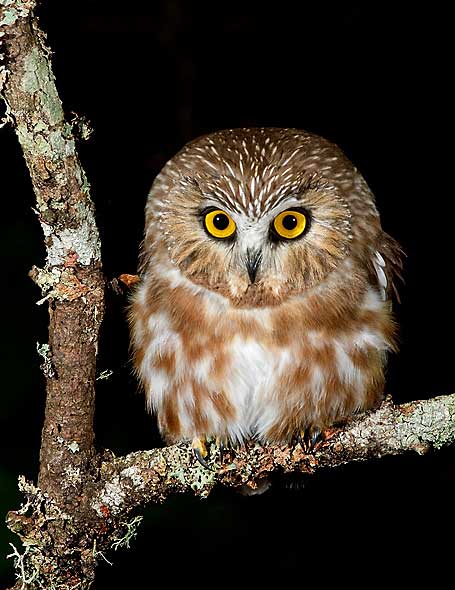
Photograph © Glenn Bartley
This species is listed as Least Concern in the IUCN Red List, but the subspecies restricted to Haida Gwaii, British Columbia is considered threatened, and it is a species of special concern in North Carolina and South Dakota.
Northern Saw-whet Owls may be a challenge to see, but they are actually pretty common in most of their range.
However, on their breeding grounds, they can be affected by logging that removes mature trees and snags. This is the main threat faced by the subspecies endemic to Haida Gwaii.
On a bright note, nest boxes can be used to help this species in places that lack natural tree cavities.
Facts
- This species is supposedly named after vocalizations that sound like someone sharpening a saw. However, no one is sure which vocalizations those might be!
- The Northern Saw-whet Owl can eat two small mice each night. This is a lot of food for such a small bird.
- Although Northern Saw-whet Owls aren’t seen very often, they are believed to be one of the most common owls in North America. Based on their large range, some sources estimate their population at 2 million birds.
- This species has highly developed hearing that may be as good as that of the Barn Owl. With that in mind, it wouldn’t be surprising if it could use its hearing to hunt mice in complete darkness.
- During the day, Northern Saw-whet Owls sometimes roost on top of a mouse they killed the night before. Birds that do this were probably too full to eat the rodent when they caught it. However, the food doesn’t go to waste. They eat the mouse when they wake up the following night.
Similar Species
The Northern Saw-whet Owl looks quite different from screech-owls and most other owl species. Even so, it could be potentially confused with a few species.
Boreal Owl
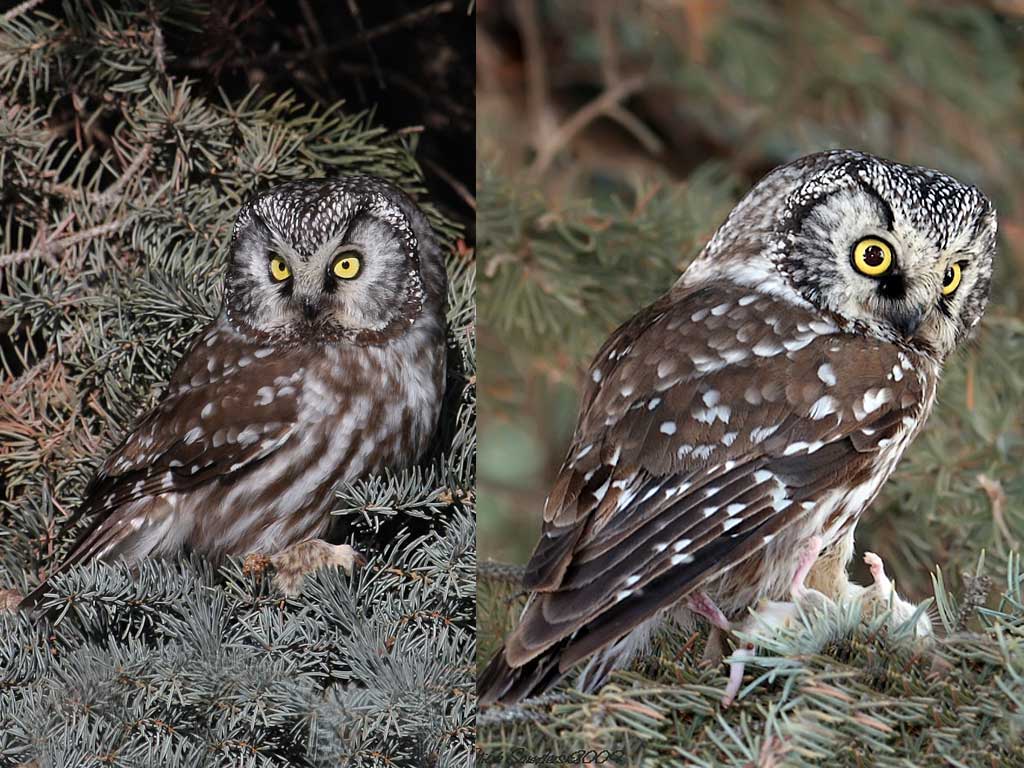
Boreal Owl
The Boreal Owl is another small owl with a similar shape. It also has yellow eyes but has a pale beak and more of a black and white head and face. Another difference is the dark brown markings on the Boreal Owl’s underparts and vent.
Elf Owl
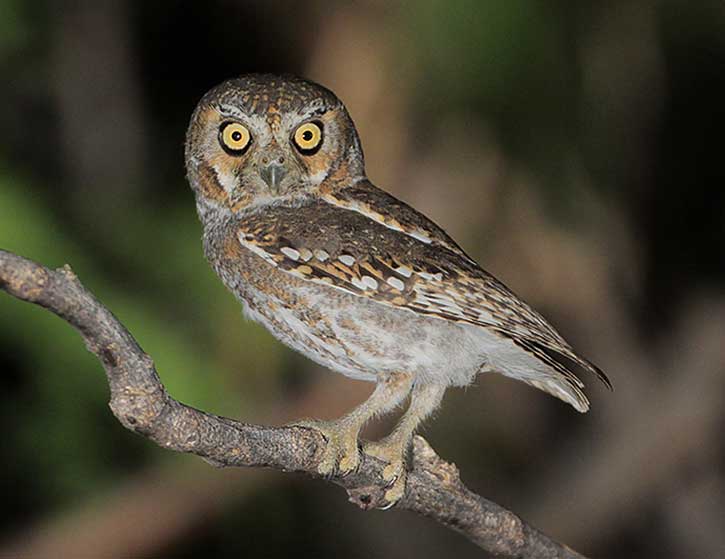
The Northern Saw-whet Owl is small, but Elf Owls are truly tiny. Around the size of a sparrow, it has more of a reddish-brown face than the saw-whet as well as paler, grayish upperparts. It also usually lives in more arid environments.
Northern Pygmy-Owl
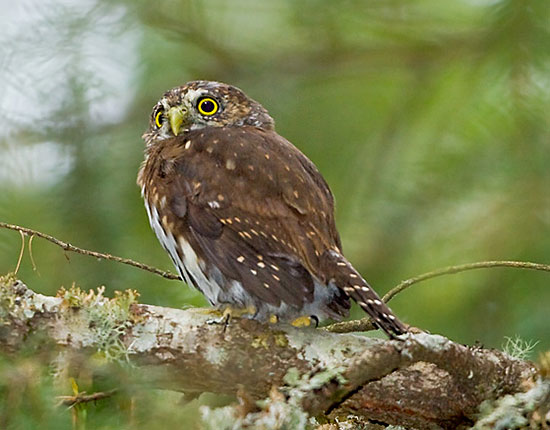
The Northern Pygmy-Owl frequents some of the same habitats and places as the Northern Saw-whet Owl. However, it is a bit smaller, and has a smaller head with a brown face.
This species also has two black “eye” marks on the back of its head, and several pale bands on its longer, more narrow tail.
Frequently Asked Questions
Where do the Northern Saw-whet Owl live?
The Northern Saw-whet Owl lives in coniferous and mixed forest in Canada and the northern and western USA. In winter, they can also migrate to wooded and semi-open habitats in many parts of the USA.
Are Northern Saw-whet Owls rare?
No, Northern Saw-whet Owls are not rare. This species is fairly common but, due to its nocturnal habits, can be very hard to see.
What is the difference between a saw-whet owl and a screech owl?
The difference between a saw-whet owl and a screech owl is that the screech owl has feathered “ear” tufts. The saw-whet owl has a round head.
What animal eats the Northern Saw-whet Owl?
Larger owls eat the Northern Saw-whet Owl. They can also be caught by several hawk and falcon species. Nestlings are susceptible to being eaten by Common Ravens, Fishers, and Martens.
What is the lifespan of a Northern Saw-whet Owl?
The lifespan of a Northern Saw-whet Owl is ten years. However, one bird in captivity lived for 16 years.

